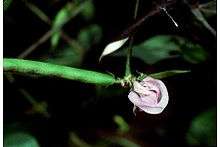Strophostyles helvola
| Strophostyles helvola | |
|---|---|
 | |
| Scientific classification | |
| Kingdom: | Plantae |
| (unranked): | Angiosperms |
| (unranked): | Eudicots |
| (unranked): | Rosids |
| Order: | Fabales |
| Family: | Fabaceae |
| Subfamily: | Faboideae |
| Tribe: | Phaseoleae |
| Subtribe: | Phaseolinae |
| Genus: | Strophostyles |
| Species: | S. helvola |
| Binomial name | |
| Strophostyles helvola (L.) Elliott | |
| Synonyms | |
| |
Strophostyles helvola (sometimes spelled S. helvula) is a species of flowering plant in the legume family known by the common names amberique-bean,[1] trailing wild bean, and trailing fuzzy-bean. It is native to eastern Canada and the eastern United States.[2]
This species is an annual vine with a fuzzy stem up to 3 m long. The leaves are usually divided into three lobes. Pea-like purple flowers grow on leafless stalks. The fruit is a fuzzy pod up to 10 cm long containing shiny black seeds with hairy coats.[3]
This bean grows in many habitat types, including disturbed areas, where it is a pioneer species, taking hold in areas where few other plants grow, and in several types of soil, especially sandy types, and it can grow in dry or moist conditions.[3] It can often be found in seaside dune habitat, where arbuscular mycorrhizae help it withstand saline conditions.[4]
This plant was used medicinally by Native American peoples. The Houma people used it to treat typhoid and the Iroquois used it topically for poison ivy irritation and warts. The Choctaw people used the roots for food.[5]
References
- ↑ "Strophostyles helvola". Natural Resources Conservation Service PLANTS Database. USDA. Retrieved 4 December 2015.
- ↑ Strophostyles helvula. NatureServe.
- 1 2 Strophostyles helvola. USDA NRCS Plant Guide.
- ↑ Tsang, A. and M. A. Maun. (1999). Mycorrhizal fungi increase salt tolerance of Strophostyles helvola in coastal foredunes. Plant Ecology 144 159-66.
- ↑ Strophostyles helvula. University of Michigan Ethnobotany.
